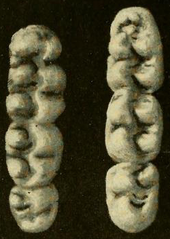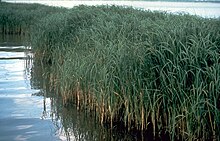Marsh rice rat
It is found mostly in the eastern and southern United States, from New Jersey and Kansas south to Florida and northeasternmost Tamaulipas, Mexico; its range previously extended further west and north, where it may have been a commensal in corn-cultivating communities.Several animals prey on the marsh rice rat, including the barn owl, and it usually lives for less than a year in the wild.[18] Bachman intended to describe the species as Arvicola oryzivora, but sent a specimen to Richard Harlan and Charles Pickering at the Academy of Natural Sciences in Philadelphia to confirm its identity.[19] Another specimen, from New Jersey, was found in the academy's collection, and Harlan took it upon himself, against Pickering's wishes, to describe the new species as Mus palustris, proclaiming it one of the few true rats of the United States.[19] Three years later, Spencer Fullerton Baird argued that the referral of the species to Arvicola was erroneous and introduced a new generic name for the marsh rice rat, Oryzomys.[7] Clinton Hart Merriam recognized O. p. natator as a separate species in 1901 and described a subspecies of it, O. p. floridanus, but considered O. p. texensis to be nearly identical to nominate O. p.[11] Also in 1955, Claude W. Hibbard described a new species of Oryzomys, O. fossilis, from Pleistocene deposits in Kansas, on the basis of small differences in characters of the tooth with living marsh rice rats.[26] Merriam and Goldman had recognized that a number of Central American species, including Oryzomys couesi and numerous forms with more limited distributions, are related to the marsh rice rat.[29] Since then, the two have generally been retained as distinct species, as supported by further research; a 1994 study even found the two to occur at some of the same places (in sympatry) in southern Texas and nearby Tamaulipas, Mexico.[36] However, Whitaker and Hamilton in their 1998 book on the Mammals of the Eastern United States recognized O. p. planirostris and O. p. sanibeli as separate subspecies, but merged all others into O. p. palustris, and placed O. argentatus as a separate species; their classification was based on their emphasis of overwater gaps as agents of biological diversification and a critique of shortcomings in Humphrey and Setzer's study, not on a reanalysis of the data.[38] The Cytb data placed all marsh rice rats studied sister to a clade containing various populations of O. couesi; the mean genetic distance between the two groups was 11.30%.The marsh rice rats fell into two main groups, differing on average by 6.05%, one containing animals from Mississippi, southwestern Tennessee, and further west, and the other including specimens from Alabama and further east.[55] The upperparts are generally gray to grayish brown, with the head a bit lighter, and are sharply delimited from the underparts, which are off-white, as are the feet.[25] The stomach has the characteristic pattern of sigmodontines (unilocular-hemiglandular); it is not split in two chambers by an incisura angularis and the front part (antrum) is covered by a glandular epithelium.[83] The papilla (nipple-like projection) on the dorsal (upper) side of the penis is covered with small spines, a character the marsh rice rat shares only with Oligoryzomys and Oryzomys couesi among oryzomyines examined.[124] The median amount of radiation needed to kill a marsh rice rat is 5.25 Gy and the lethal dose of potassium cyanide is 7.20 mg/kg; both values are relatively low for cricetid rodents.[127] When the pineal gland is removed or melatonin is administered in male rice rats, the testes are reduced and tend to regress into the body.Perhaps a warm period during the Quaternary enabled the rice rat to disperse northward and when the climate cooled, relict populations were able to survive in the north as commensals in corn-cultivating Native American communities.[135] Some subfossil animals are slightly larger than living marsh rice rats, possibly because environmental constraints were relaxed in commensal populations.[142] In southern Illinois, marsh rice rats are more likely to occur in wetlands with more herbaceous cover, visual obstruction, and nearby grasslands.They build nests of sedge and grass, about 13 cm (5 in) large, which are placed under debris, near shrubs, in short burrows, or high in aquatic vegetation.Other predators include birds such as marsh hawks (Circus cyaneus), and barred owls (Strix varia); snakes such as cottonmouths (Agkistrodon piscivorus); alligators (Alligator mississippiensis); and carnivorans like raccoons (Procyon lotor), red foxes (Vulpes vulpes), American mink (Neogale vison), weasels (Mustela and Neogale sp.Vitamin E, fluoride, and iodide protect against bone loss associated with this disease in the rice rat and a high-sucrose diet increases the severity of periodontitis.Plants eaten include species of Spartina, Salicornia, Tripsacum, and Elymus, among others; it mainly eats seeds and succulent parts.[158] In 1931, Arthur Svihla noted that virtually no information had been published on the habits and life history of the marsh rice rat since the 1854 publication of Audubon and Bachman's description.[185] The marsh rice rat is the primary host of the Bayou virus (BAYV), the second-most common agent of hantavirus infections in the United States.[189] Antibodies against Borrelia burgdorferi, the bacterium that causes Lyme disease in the United States, have been found in marsh rice rats in Virginia, Maryland, North Carolina, and Tennessee.[191] The 2016 IUCN Red List assesses the conservation status of the marsh rice rat as "Least Concern", because it is a common, widespread, and stable species without major threats that occurs in several protected areas.[195] A 2001 study projected that climate change would reduce the range of the marsh rice rat in Texas,[196] where it is now common, but may become threatened by habitat loss in the future.[197] A study at the Paducah Gaseous Diffusion Plant found that rice rats accumulate more polychlorinated biphenyls, but less heavy metal than white-footed mice (Peromyscus leucopus).






RancholabreanConservation statusLeast ConcernIUCN 3.1Scientific classificationEukaryotaAnimaliaChordataMammaliaRodentiaCricetidaeSigmodontinaeOryzomysBinomial nameHarlanOryzomys couesiSynonymssemiaquaticrodentwetlandswampssalt marshesNew JerseyKansasFloridaTamaulipascommensalbrown ratJohn BachmansubspeciesFlorida Keysmitochondrialcytochrome bbarn owlmany different parasiteshantavirusUnited StatesSouth AmericaO. gorgasiOryzomyinicotton ratsSouth CarolinaRichard HarlanCharles PickeringAcademy of Natural Sciencesspecific nameArvicolaGeorgiaSpencer Fullerton Bairdgeneric namesubgenusHesperomystype speciesClinton Hart MerriamnominateEdward Alphonso GoldmanPine IslandFort MyersSanibel IslandClaude W. HibbardPleistocenekaryotypessympatryCudjoe KeyMammal Species of the WorldmicrosatelliteEvergladesmorphometricalnuclearinterphotoreceptor retinoid-binding proteinintronalcohol dehydrogenasecommon namesbrown ratscheek pouchesguard hairsmammaeungual tuftsinterdigital websGulf Coaststomachunilocularincisura angularisglandular epitheliumgall bladdersynapomorphykaryotypesex chromosomesX chromosome inactivationLINE-1retrotransposonsautosomal recessivehematocritholotypeCape Sable, Floridaglans penisbaculumcovered by small spinesOligoryzomysHolochilus brasiliensispreputial glandsventralprostateanteriordorsalvesicular glandpremaxillarylacrimalfrontalmaxillary boneszygomatic platezygomatic archjugal bonessphenopalatine foramenregion between the eyesbraincaseinterparietal boneincisive foraminapalateposterolateral palatal pitssphenopalatine vacuitiesarteriesderivedsubsquamosal fenestrasquamosal bonetegmen tympani